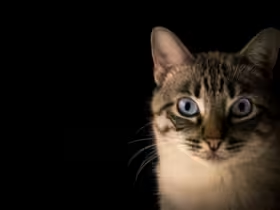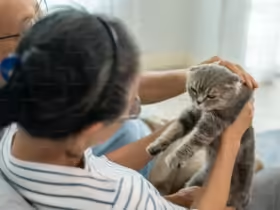6 Common Eye Problems in Cats: What You Need to Know
Cats are known for their keen senses, and their eyes are no exception. They rely heavily on their vision for hunting, exploring, and navigating their environment. However, eye problems in cats can occur and may range from minor irritations to serious conditions requiring veterinary attention. Understanding these common eye problems can help you detect issues early and seek appropriate treatment. Here’s an in-depth look at six common eye problems in cats, their symptoms, causes, and treatments.
1. Conjunctivitis
Overview
Conjunctivitis, often referred to as “pink eye,” is an inflammation of the conjunctiva, the thin membrane covering the white part of the eye and the inner surface of the eyelids. It can affect one or both eyes.
Symptoms
- Redness and swelling of the eye
- Discharge that may be clear, yellow, or green
- Squinting or blinking frequently
- Excessive tearing
- Rubbing or scratching the eye
Causes
- Infections: Bacterial, viral (e.g., feline herpesvirus), or fungal infections can lead to conjunctivitis.
- Allergies: Environmental allergens or irritants like dust or smoke.
- Foreign Bodies: Debris or particles stuck in the eye.
- Underlying Conditions: Conditions like feline calicivirus or chlamydia.
Diagnosis and Treatment
- Diagnosis: A vet will perform an eye examination and may take samples for laboratory analysis if an infection is suspected.
- Treatment: Depends on the cause:
- Infections: Antibiotic or antiviral eye drops/ointments.
- Allergies: Antihistamines or corticosteroids.
- Foreign Bodies: Removal by a vet.
- Underlying Conditions: Specific treatments targeting the root cause.
2. Corneal Ulcers
Overview
Corneal ulcers are painful sores on the cornea, the clear, dome-shaped surface of the eye. They can result from trauma, infections, or other eye conditions.
Symptoms
- Redness and swelling
- Discharge
- Squinting or blinking
- Cloudy or opaque appearance of the cornea
- Sensitivity to light
- Excessive tearing
Causes
- Trauma: Scratches or injuries to the cornea.
- Infections: Bacterial, viral, or fungal infections.
- Dry Eye: Insufficient tear production leading to dryness and irritation.
- Eye Diseases: Such as feline herpesvirus.
Diagnosis and Treatment
- Diagnosis: Eye examination with fluorescein staining to identify ulcers and determine their severity.
- Treatment:
- Medications: Antibiotic or antifungal eye drops/ointments.
- Pain Relief: Analgesics to manage discomfort.
- Preventative Measures: Protect the eye from further injury, and ensure proper tear production if dry eye is the cause.
3. Uveitis
Overview
Uveitis is inflammation of the uvea, the middle layer of the eye that includes the iris, ciliary body, and choroid. It can cause significant discomfort and vision problems.
Symptoms
- Redness and swelling
- Cloudy or hazy appearance of the eye
- Sensitivity to light
- Excessive tearing
- Squinting
- Pain
Causes
- Infections: Bacterial, viral, or fungal infections.
- Autoimmune Diseases: Conditions where the immune system attacks the eye.
- Trauma: Injury to the eye.
- Systemic Diseases: Conditions like feline leukemia virus (FeLV) or feline immunodeficiency virus (FIV).
Diagnosis and Treatment
- Diagnosis: Comprehensive eye examination and possibly blood tests to identify underlying causes.
- Treatment:
- Medications: Anti-inflammatory drugs, such as corticosteroids, to reduce inflammation.
- Treatment of Underlying Conditions: Addressing any systemic or infectious causes.
- Pain Management: Analgesics for discomfort.
4. Glaucoma
Overview
Glaucoma is a condition characterized by increased pressure within the eye, leading to damage to the optic nerve. It’s a serious condition that can result in vision loss if not treated promptly.
Symptoms
- Redness and swelling
- Cloudy or bulging appearance of the eye
- Excessive tearing
- Squinting
- Vision loss or behavioral changes, such as bumping into objects
Causes
- Primary Glaucoma: Inherited condition where the eye’s drainage system is abnormal.
- Secondary Glaucoma: Resulting from other conditions, such as uveitis, eye trauma, or tumors.
Diagnosis and Treatment
- Diagnosis: Measurement of intraocular pressure (tonometry), along with a thorough eye examination.
- Treatment:
- Medications: To reduce intraocular pressure and manage symptoms.
- Surgery: In severe cases, surgical intervention may be necessary to relieve pressure.
- Management of Underlying Conditions: Address any contributing factors, such as uveitis or tumors.
5. Cataracts
Overview
Cataracts are characterized by the clouding of the lens inside the eye, which can impair vision. They can develop gradually and may affect one or both eyes.
Symptoms
- Cloudy or opaque appearance of the eye
- Difficulty seeing or changes in vision
- Increased sensitivity to light
- Behavioral changes, such as bumping into objects or difficulty navigating
Causes
- Genetics: Some breeds are more prone to cataracts.
- Age: Cataracts can develop as part of the aging process.
- Injury: Trauma to the eye can lead to cataract formation.
- Systemic Diseases: Conditions like diabetes.
Diagnosis and Treatment
- Diagnosis: Eye examination and visual assessment.
- Treatment:
- Surgery: The primary treatment for cataracts involves surgically removing the cloudy lens and replacing it with an artificial lens.
- Management: Address any underlying systemic diseases that may contribute to cataract formation.
6. Cherry Eye
Overview
Cherry eye is the prolapse of the third eyelid gland, also known as the nictitating membrane. This gland becomes swollen and protrudes from the corner of the eye.
Symptoms
- Red, swollen mass in the corner of the eye
- Excessive tearing
- Discharge
- Possible irritation or discomfort
Causes
- Weak Ligaments: The gland’s supporting structures may become weakened or loose.
- Genetics: Some breeds are more susceptible.
Diagnosis and Treatment
- Diagnosis: Physical examination of the eye.
- Treatment:
- Surgical Replacement: The gland may need to be repositioned surgically to restore normal function.
- Medications: Anti-inflammatory eye drops or ointments to reduce swelling and discomfort.
When to See the Vet
If you notice any signs of eye problems in your cat, it’s crucial to consult a veterinarian promptly. Eye issues can worsen quickly and may lead to serious complications if left untreated. Early diagnosis and treatment are key to preserving your cat’s vision and overall health.
Diagnostic Approach
Veterinary diagnosis of eye problems typically involves:
- Physical Examination: To assess the overall health of the eye.
- Eye Tests: Such as fluorescein staining, tonometry, or slit-lamp examination.
- Blood Tests: To identify systemic conditions contributing to eye problems.
- Imaging: In some cases, imaging techniques may be used to evaluate internal structures.
Conclusion
Cats’ eyes are vital to their well-being, and recognizing the signs of common eye problems can help ensure timely intervention. From conjunctivitis to cherry eye, understanding these conditions and their treatments can make a significant difference in your cat’s quality of life. Always consult your veterinarian if you notice any changes in your cat’s eyes to get an accurate diagnosis and appropriate care. By staying vigilant and informed, you can help keep your feline friend’s eyes healthy and clear.










Leave a Reply